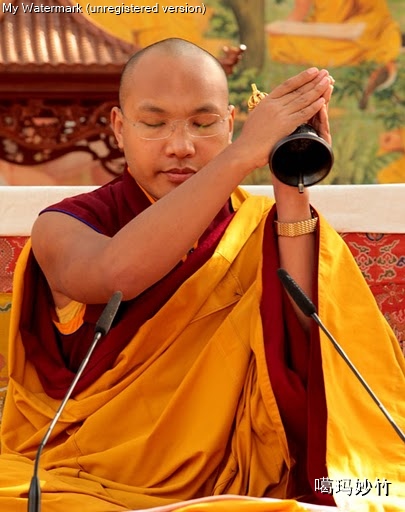法王新闻 | 2010年12月
『第28屆噶舉祈願』第6天:不动佛灌顶暨开示
『28th Kagyu Monlam』AKSHOBHYA EMPOWERMENT
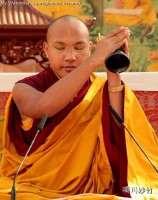
時間:2010年12月20日 9:00-11:00am 20th Dec., 2010
地點:印度 菩提迦耶 正覺大塔 Mahabodhi Stupa, Bodhigaya, India
藏譯中:堪布丹傑、乘宗法師
攝影:噶瑪善治、噶瑪諾布、班瑪歐色多傑、廖國明、廖佳基
報導:黃靖雅
以保護地球眾生的心,領受這個灌頂,這樣我們的動機、行持就是清淨的,
就能真正領受到這個殊勝法。
The Akshobhya Empowerment: Entering the Vajra Family
■第二座法:
For today’s empowerment, many people have come and fill to overflowing the space around the stupa. The Karmapa’s throne is higher today, covering up the statue of the baby Buddha behind him. Next to his throne and holding up a long curving branch of the Bodhi Tree, a green iron pillar is wrapped in spirals of orange and yellow marigolds. After the Mahamudra lineage prayer, tea and buns for all, the empowerment begins.
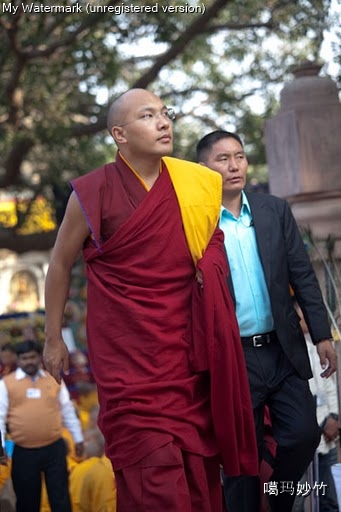
上午9:00,法王蒞臨,於佛陀法像前行三次大禮拜,陞法座。
(大眾起立,頂禮三拜)
維那師帶領大眾念誦:
〈金剛總持祈請文〉(《大祈願課誦本》P133)
(大眾飲用茶點前,維那師帶領大眾念誦供養文〈免信施難消〉)
(法王開始修持「不動佛」儀軌)
〈獻曼達〉
法王開示:
His Holiness explains that this is a maturing empowerment, which means that its purpose is to place the imprint of the deity within our mind stream and also that there will be no requirements for practice.
After His Holiness performs the first part of the empowerment, he addresses those gathered, saying that the special commitment Akshobhya Buddha made is not to harm others and to benefit living beings. The Akshobhya Mandala Ritual says:
As Akshobhya gave rise to bodhicitta
Making the first of eight aspirations,
“May my mind never be angry or wishing to harm others.”
Thus may I, too, accomplish them all.
[His Holiness had mentioned in an earlier talk that his mind was more peaceful in Tibet and he did not get angry easily. Whereas in India, with all the problems, it was easier to become angry. But then he developed an interest in Akshobhya and in this practice, which was very helpful. Perhaps he was thinking of this verse.]
His Holiness continues to say that we should imagine Akshobhya to be inseparable from our lama. If we can do the practice well, we can purify even the five limitless actions that have immeasurable negative consequences. Further, we can also think that this empowerment will help to develop our compassion for all living beings. Most masters say that the practice of Akshobhya belongs to the Kriya or Action Tantra. This first level of the tantras also spread in China during the Tang Dynasty though the tradition of practicing it later disappeared.
The practice of Akshobhya is particularly apt for our time of the five degenerations, (of wrong view, afflictions, strife, life span, and the well-being of body and mind), when the afflictions are strong and living beings hard to train. It is also true that all the advances in technology have made it possible to do greater harm with less effort. So, for example, fishermen, butchers, and hunters make an even worse misfortune for themselves than before. We have also depleted our natural environment and diminished the number and variety of the animals who live there. We have razed primal forests and done tremendous harm to our environment. The responsibility that we have for all this damage has become greater as our impact grows.
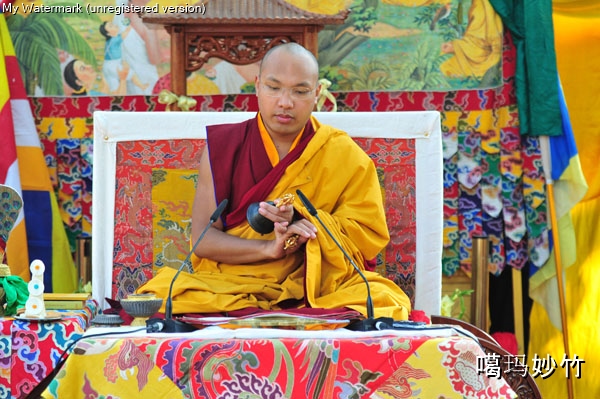
Then came the mandala and long life offerings with the lines of devotees becoming longer each day. When he continues, the Karmapa speaks of the importance of Akshobhya in many of the Kagyu lineages; the Drugpa, Drikung, and Taklung.
關於「不動佛修法」,噶舉四大八小中的竹巴噶舉、止貢噶舉有很多儀軌和觀修法門;達隆湯巴大師也有即是「不佛化身」的說法,在達隆噶舉中也很重視「不動佛修法」。
For the Kamtsang Kagyu, the sixth Shamar, Chokyi Wangchuk, composed a sadhana, called “The Ornament of Abhirati” and among the many commentaries on this are those by Situ Chokyi Jungne and Jamgon Kongtrul Lodro Thaye. This particular empowerment was composed by the tenth Shamar and it is found in many of the Kagyu traditions.
至於岡倉噶舉也有很重要的著作,第六世夏瑪巴確吉旺秋寫了《現喜淨土》這樣莊嚴的法本,蔣貢康楚仁波切也針對這部論作了註解釋論,大司徒確吉迥內的一位弟子也寫了一部「不動佛」的註解。今天要給的不動佛灌頂,是根據某一世的夏瑪仁波切所寫的法本。
由此可見,「不動佛」法門在噶舉傳承非常興盛,我們藏傳的其他教派薩迦、寧瑪、格魯,也都很重視這個法門,例如薩迦派諾千大師傳承的續部「不動佛」儀軌。
今天要給的「不動佛」灌頂,非常殊勝,我無法一下子說完它所有的功德利益,最主要是和「事部瑜伽」有關;但在普敦仁波切所寫的儀軌中,提到行部壇城中被所有本尊所環繞的是不動佛,這位大師說祂是行部本尊。一般我們會說不動佛是事部當中金剛部的本尊,「部」就是「家族」的意思,事部中有三族:如來族、蓮花族、金剛族,如來族主尊是釋迦牟尼佛,部主是文殊師利菩薩;蓮花族主尊是阿彌陀佛,部主是觀世音菩薩;
Among the five buddha families, Akshobhya is the Lord of the vajra family according to Atisha and Padma Karpo.
金剛族主尊是不動佛,部主是金剛手菩薩。在金剛族當中,最主要的本尊是不動佛。
在漢地,唐朝時密續也很興盛,當時弘傳的大師是「開元三大士」:善無畏、金剛智、不空,唐朝密續興盛時,不動佛法脈也傳到日本,也說不動佛是事部的金剛部族。
■末法時代,淨除罪障最勝法

「不動佛」修法的特殊功德是淨除罪障,以人為主的一切眾生,在五濁惡世中煩惱都特別重,而且都很難對治,科技很發達,反而有機會造作更重的惡業,譬如說漁夫、獵人,以前社會就有,但和現代相比,現代屠夫手中掌握的是更大的機器,所造的殺業更大。還有大自然的森林、大地等外器世間都快被我們消耗殆盡了。我們就是在這樣一個世代中,由於佛陀的大悲心,會特別關注到誰需要喜樂、誰需要被救怙,佛陀為了末法時期罪業特別重大的眾生,特別開示了淨除罪障的「不動佛」法門,特別適合這個時代,我們若能好好修持是很重要的。
The Karma Kagyu has a special connection to vajra family and Akshobhya. The primary practices of many masters in our lineage, such as Guhyasamaja and Hevajra, belong to the vajra family. Further, the Karmapa is said to be an emanation of Akshobhya, and some of the previous Gyalwang Karmapas have stated, “I am an emanation of Akshobhya.” As a symbol of this connection, they wear the crown with a vajra in the front. Actually, the famous Black Crown (or Hat) is not really black but a deep, dark blue to represent the depth of space. Just as space is unchanging, so is the dharmata, (the nature of mind or suchness).
整個岡倉噶舉都特別能修持金剛族的本尊,這個淨除罪業的殊勝傳承,像尊聖的「噶舉三祖師」馬爾巴、密勒日巴、岡波巴三位大師,最主要修持的密續本尊是勝樂金剛、密集金剛、喜金剛,都是金剛族的本尊,歷代噶瑪巴的心意也都是修持金剛族的本尊;甚至有「噶瑪巴即是不動佛化身」的說法。歷代噶瑪巴戴黑寶冠行持佛事業,其實「黑寶冠」是深藍色,像虛空一般,是「不變法性」的象徵。
This is the deeper meaning of the color of the crown, which is said to bring liberation upon seeing. It is also true that each of the buddha families has a different colored crown and that of Akshobhya is blue.
法帽具有「見即解脫」的功德,五佛部的灌頂有寶冠的灌頂,金剛族的寶冠灌頂即是深藍色寶冠。
We are very fortunate that not only can we do the practice of Akshobhya, we can also encounter him. This practice is important for purifying our negative actions, and we can do this by taking on all the misdeeds of all living beings, making them our own, and then confessing them.
我們都很幸運,能接觸到佛陀所傳淨除罪障的「不動佛」法門,而且灌頂和儀軌都還存在,真的很幸運,尤其是在這樣一個罪業快速成熟的時代,我們更應幫助世界、幫助所有眾生來淨除罪障。我之前在講解「淨除罪障」時曾提到,要觀想所有眾生的罪障都集合到我身上,然後我就這樣一起懺悔,希望大家這樣來修持「不動佛法」懺除罪障。
密乘的方便法非常殊勝,把握一個法,就能除所有障礙。你看金剛座附近有多少塵土,就觀想每一個塵土上都有十方無量佛菩薩,以廣大的心量,讓我們身口意都清淨的來作禮拜、讚漢、供養、懺悔等,就能累積到盡虛空、遍法界的無量功德。
We are in a special place now and so we must make vast aspirations not just for ourselves but for all living beings. If we just take the empowerment to gain things in this life—good health, long life, money, and children —there’s not much point. We don’t need to practice Dharma for this; we can get them in many other ways.
今天我們在這金剛座前,都有這樣的責任,為世界、為每個生命淨除罪障,我們也可以以保護地球眾生的心,來領受這個灌頂,這樣我們的心、我們的行持就是清淨的,就能真正領受到這個殊勝法。如果只是為了自身的利益,為了自己的財富、子孫,如果你只是想得今生暫時的快樂,其實不需要這麼殊勝的法。
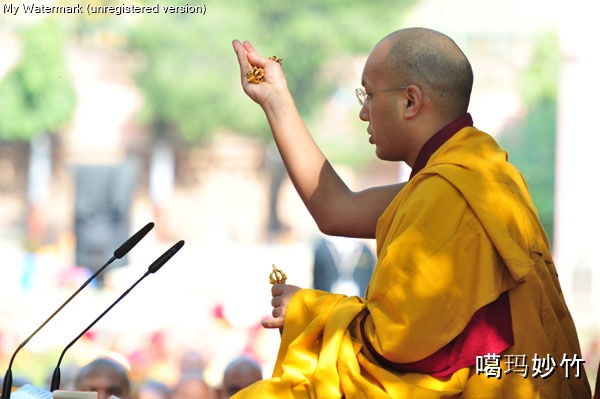
(法王帶領大眾念誦祈請文三次,大眾跟隨念誦,「祈請傳法上師給予灌頂」,念三次,「念完之後要生起歡喜心」)
Generally, when we talk about the secret mantrayana, we say that it is for appropriate disciples, those of the highest faculties who can actually do the practice. There are many levels to understand. If we take the texts literally, there is a great danger. So we have to look at ourselves to see if we are appropriate vessels for the vajrayana or not. However that may be, we are now taking this empowerment so we have to “try.” [spoken in English].
密乘是對「最上根器」,「第一名」、根器成熟的弟子所說,可以在一生中成佛,或八至十六世中成佛。如果不是法器而來修持,可能會產生誤解,因為密乘中有很多了義、不了義的象徵詞句,如果不了它的深義可能產生誤解,甚至錯誤的修持。所謂「如法」的弟子,真的很難判斷,我也很難知道誰是不是適合的法器,每個人都有自己細微的性格和習氣,所以很難知道別人是不是適合的根器來領受這樣的灌頂,但共同的是我們都有煩惱,所以我們可以「try」,試著來接受這樣的法。
但我剛說過,密續是上根器修的法,不能輕忽的來修持,如果根器、程度不到,不能自己想修就修。如果弟子不具根器,上師又很輕忽大意的給予灌頂,是有危險的。但各位都帶著清淨的發心和行持來到這裡,相信各位都是具足信行的弟子,我就這樣給各位灌頂。
We are in the presence of the greatly meritorious Bodhi Tree. If we need to gather the accumulations and purify afflictions, now is the time.
■前行:皈依發菩提心
His Holiness then gives the sections of the empowerment and makes the dedication that the lamas live for a very long time and that the teachings also continue to benefit beings.
(法王念誦儀軌)
接下來,我們要觀想,在壇城中間,上師就是不動佛。我們不必特別觀想別的壇城,都在這個自然任運形成的金剛座,就是一個殊勝的壇城,這個千佛成道的地方,就是不動佛壇城。這樣一個殊勝壇城的中間,坐著的,就是與上師無二無別的藍色不動佛,持定印,定印上持五股金剛杵,周圍圍繞著十方一切佛菩薩,在不動佛和十方諸佛菩薩、在這樣一個殊勝的「福德境」(皈依境)之前,我們要把握機會,這就是我們淨除罪障、積聚福德的機會,我們要以這樣的心情,專注念誦〈皈依文〉和〈七支供養文〉。
之前有些弟子請求我給予「皈依戒」,其實這個「不動佛」儀軌當中就有「皈依戒」,得到皈依戒才是佛教徒,想成為佛弟子,重視「皈依戒」是很重要的,還要了解皈依之後,什麼該做,什麼不該做。現在,想皈依的人,就跟著我一起念「皈依文」:
我從今起,盡形壽,
皈依佛,皈依法,皈依僧(三次)
接著你要想你得到「皈依戒」了。接著是「菩提心戒」,沒有接受菩提心戒,是不能接受「不動佛」灌頂的,就是「發起為利眾生願成佛」的發心,並且以行動實踐這樣的發心,作為自己的學處。「菩薩戒」有十八個墮罪,這是一個培養大悲心的方便法門,重點是盡量學習菩薩的行持。剛開始,有些菩薩只行持一個或四個行持,這樣慢慢培養悲心,可以看自己狀況來修持。接下來,請跟著念誦:
「菩提心戒」:
我皈依三寶,我淨除罪障,我隨喜一切善業功德,
未證菩提之前,我恆常憶念著上師、佛陀,皈依佛菩薩眾,
為了自他二利,我發起殊勝的菩提心,
發起菩提心之後,我成為服侍眾生的僕人,行持殊勝的菩薩行,
為了利益眾生,我發願成就佛道。(三次)
念誦三次之後,要想「我得到菩薩戒了」;如果不想領受「菩薩戒」這個學處,可以心中發願「我願利益眾生成佛」,這樣就可以了。
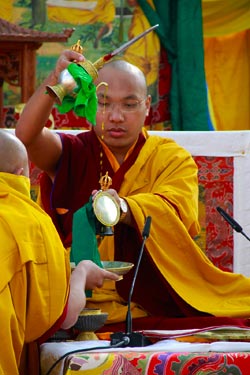
■正行灌頂
接下來,是「不動佛」的灌頂的「正行」。有「水」的灌頂,和「佛冠」的灌頂。
首先,是水的「寶瓶灌頂」,要觀想不動佛手持盛裝甘露的寶瓶,從我們頭頂倒入甘露,甘露的本質就是智慧,剎那間本智的甘露充滿我們全身,我們所有的煩惱罪障就得到了清淨。
接下來是「佛冠的灌頂」。
很多弟子請求我傳「不動佛心咒」,接下來我就會給予「不動佛心咒」的口傳,這是「淨除罪障的羅陀尼」。(法王口傳〈不動佛心咒)三遍,增訂本P71)
■結行灌頂
「結行」有八吉祥天女所給予的八吉祥灌頂。
(法王修持儀軌)
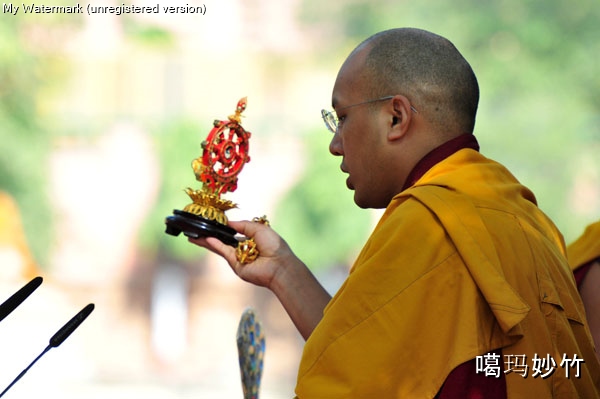
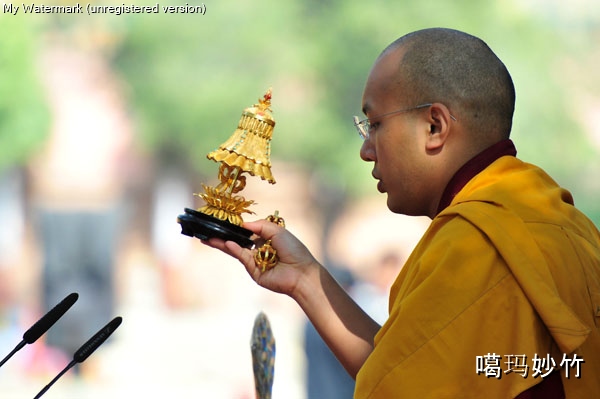
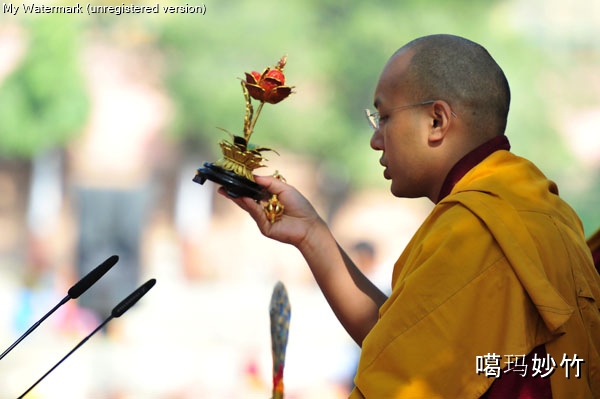
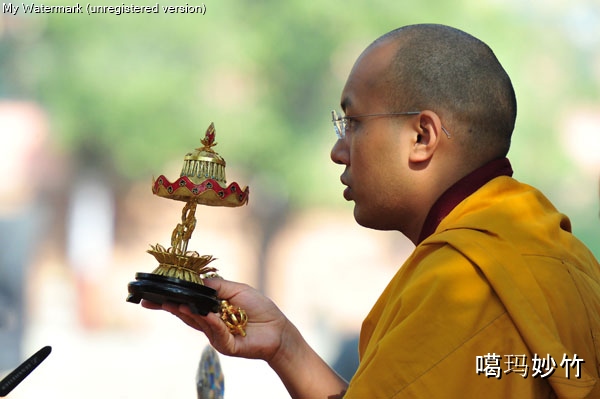
我們要思維自己得到了這個灌頂,從此之後,就像穿上金剛的鎧甲,以後不再受到任何魔障、煩惱的侵擾,受到金剛鎧甲的保護。
現在我們得到灌頂了。接著,要念誦「吉祥文」。得到灌頂之後,沒有不用持守三昧耶戒的。有的大師說,接受「事部灌頂」之後,至少要具備一種「別解脫戒」,如斷除惡行的「五戒」中的一戒;有的大師說,接受「事部灌頂」之後,就必須要持守「菩薩戒」;也有大師說,在事部瑜伽中,要持守「密乘戒」(三昧耶戒)。有各種不同的說法,聖者所說的話都具有真實性,接受「事部灌頂」之後最主要的是要持守「菩薩戒」,還有剛才那兩個灌頂的根本和支分的三昧耶戒。只要你不違反基本戒律,能夠持守戒律,即使你不修這個法,都可以在八生之中,得到金剛持的果位。聽起來容易,但真的做起來,並不容易。

(獻曼達)這是感謝上師傳法的供養。
大地塗香敷妙花,虛彌四洲日月嚴,觀為佛國作供獻,有情咸受清淨剎。
(迴向)
以此功德願證佛自性,降伏煩惱怨敵之過患,
生老病死湏湧之波濤,願度眾生解脫輪迴海。
He further gives a reading transmission for the preliminary practice he composed and also for “The King of Aspiration Prayers.”
接著,我要口傳我所彙編的「四加行」法本口傳(中文法本《報告法王:我做四加行》)。
法王獨頌〈大祈願文〉(《大祈願課誦本》P242),大眾恭敬聆聽,心中跟隨默念。
接著,法王獨誦〈冥陽迴向文〉(P260)。
維那師帶領大眾念誦〈祈願成就真言〉(P267)
〈發菩提心文〉:
勝菩提心寶,未生令生起,生已勿退轉,願輾轉增長。
